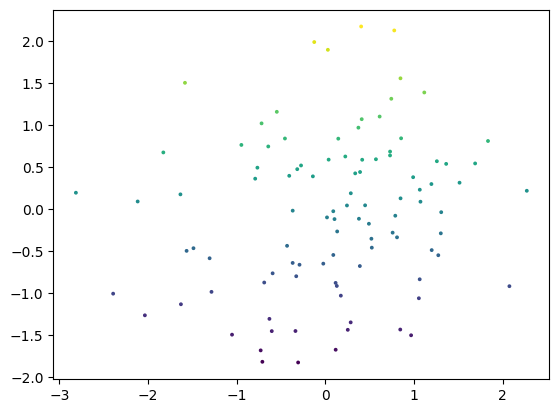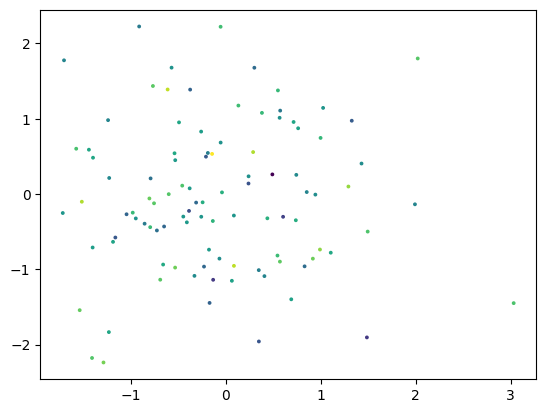PyData Library Styles#
This theme has built-in support and special styling for several major visualization libraries in the PyData ecosystem. This ensures that the images and output generated by these libraries looks good for both light and dark modes. Below are examples of each that we use as a benchmark for reference.
Pandas#
[1]:
import string
import numpy as np
import pandas as pd
rng = np.random.default_rng(seed=15485863)
data = rng.standard_normal((100, 26))
df = pd.DataFrame(data, columns=list(string.ascii_lowercase))
df
[1]:
| a | b | c | d | e | f | g | h | i | j | ... | q | r | s | t | u | v | w | x | y | z | |
|---|---|---|---|---|---|---|---|---|---|---|---|---|---|---|---|---|---|---|---|---|---|
| 0 | 1.064993 | -0.835020 | 1.366174 | 0.568616 | 1.062697 | -1.651245 | -0.591375 | -0.591991 | 1.674089 | -0.394414 | ... | -0.378030 | 1.085214 | 1.248008 | 0.847716 | -2.009990 | 2.244824 | -1.283696 | -0.292551 | 0.049112 | -0.061071 |
| 1 | 0.175635 | -1.029685 | 0.608107 | 0.965867 | -0.296914 | 1.511633 | 0.551440 | -2.093487 | -0.363041 | -0.842695 | ... | -1.184430 | -0.399641 | 1.149865 | 0.801796 | -0.745362 | -0.914683 | -0.332012 | 0.401275 | 0.167847 | -0.674393 |
| 2 | -1.627893 | -1.132004 | -0.520023 | 1.433833 | 0.499023 | 0.609095 | -1.440980 | 1.263088 | 0.282536 | 0.788140 | ... | 1.330569 | 0.729197 | 0.172394 | -0.311494 | 0.428182 | 0.059321 | -1.093189 | 0.006239 | 0.011220 | 0.882787 |
| 3 | 0.104182 | -0.119232 | 1.426785 | 0.744443 | 0.143632 | 0.342422 | 0.591960 | 0.653388 | -0.221575 | -0.305475 | ... | -0.117631 | -0.705664 | -0.041554 | 0.365820 | 1.054793 | 0.280238 | -0.302220 | -1.105060 | -1.344887 | -0.186901 |
| 4 | 0.404584 | 2.172183 | -0.498760 | -0.537456 | -0.174159 | -0.421315 | -0.461453 | -0.456776 | -0.811049 | 0.470270 | ... | -0.970498 | -0.424077 | 0.017638 | 0.764396 | -0.055982 | 0.369587 | 0.566487 | -0.709265 | 0.041741 | 1.427378 |
| ... | ... | ... | ... | ... | ... | ... | ... | ... | ... | ... | ... | ... | ... | ... | ... | ... | ... | ... | ... | ... | ... |
| 95 | 0.730475 | 0.638252 | -1.327878 | 0.402921 | 0.300998 | -2.103696 | 0.177649 | 0.226409 | 0.391869 | -2.687118 | ... | -1.019080 | 0.449696 | 0.603108 | 1.325479 | -0.354819 | -0.122947 | -0.555267 | -0.319204 | 1.543449 | 1.219027 |
| 96 | -1.563950 | -0.496752 | -0.135757 | 1.468133 | -0.255600 | -0.551909 | 1.069691 | 0.656629 | -1.674868 | -0.192483 | ... | -0.197569 | 1.751076 | 0.536964 | 0.748986 | -0.631070 | -0.719372 | 0.053761 | 1.282812 | 1.842575 | -0.250804 |
| 97 | 0.116719 | -0.877987 | -0.173280 | -0.226328 | 0.514574 | 1.021983 | -0.869675 | -1.426881 | 1.028629 | -0.403335 | ... | -0.328254 | 1.291479 | 0.540613 | 0.876653 | -0.129568 | -0.756255 | 0.614621 | 0.747284 | -0.416865 | -1.230327 |
| 98 | 0.744639 | 1.312439 | 1.144209 | -0.749547 | 0.111659 | -0.153397 | -0.230551 | -1.585670 | -0.279647 | 0.482702 | ... | 1.193722 | -0.229955 | 0.201680 | -0.128116 | -1.278398 | -0.280277 | 0.109736 | -1.402238 | 1.064833 | -2.022736 |
| 99 | -2.392240 | -1.005938 | -0.227638 | -1.720300 | -0.297324 | -0.320110 | -0.338110 | -0.089035 | -0.009806 | 1.585349 | ... | 0.717063 | 0.589935 | 0.718870 | 1.777263 | -0.072043 | -0.490852 | 0.535639 | -0.009055 | 0.045785 | 0.322065 |
100 rows × 26 columns
All the cells in the previous data frame are roughly the same length/width. The next table has more varied types of data. This is useful for checking the effects of CSS.
[2]:
# car data taken from Bokeh sample data (`pip install bokeh-sampledata`)
# from bokeh_sampledata.autompg2 import autompg2 as mpg
# del mpg['Unnamed 0']
# mpg_csv = mpg.sample(n=20).to_csv()
import io
mpg_csv = io.StringIO(
",manufacturer,model,displ,year,cyl,trans,drv,cty,hwy,fl,class\n"
"162,Subaru,Forester Awd,2.5,2008,4,manual(m5),4x4,19,25,p,suv\n"
"36,Chevrolet,Malibu,3.6,2008,6,auto(s6),front,17,26,r,midsize\n"
"133,Land Rover,Range Rover,4.6,1999,8,auto(l4),4x4,11,15,p,suv\n"
"102,Honda,Civic,1.6,1999,4,manual(m5),front,23,29,p,subcompact\n"
"47,Dodge,Caravan 2wd,4.0,2008,6,auto(l6),front,16,23,r,minivan\n"
"84,Ford,F150 Pickup 4wd,4.2,1999,6,manual(m5),4x4,14,17,r,pickup\n"
"168,Subaru,Impreza Awd,2.5,1999,4,auto(l4),4x4,19,26,r,subcompact\n"
"149,Nissan,Maxima,3.5,2008,6,auto(av),front,19,25,p,midsize\n"
"158,Pontiac,Grand Prix,5.3,2008,8,auto(s4),front,16,25,p,midsize\n"
"50,Dodge,Dakota Pickup 4wd,3.9,1999,6,auto(l4),4x4,13,17,r,pickup\n"
"58,Dodge,Durango 4wd,4.7,2008,8,auto(l5),4x4,13,17,r,suv\n"
"28,Chevrolet,K1500 Tahoe 4wd,5.3,2008,8,auto(l4),4x4,14,19,r,suv\n"
"116,Hyundai,Tiburon,2.0,1999,4,manual(m5),front,19,29,r,subcompact\n"
"97,Ford,Mustang,4.6,2008,8,auto(l5),rear,15,22,r,subcompact\n"
"80,Ford,Explorer 4wd,4.0,2008,6,auto(l5),4x4,13,19,r,suv\n"
"232,Volkswagen,Passat,2.8,1999,6,manual(m5),front,18,26,p,midsize\n"
"219,Volkswagen,Jetta,2.8,1999,6,auto(l4),front,16,23,r,compact\n"
"72,Dodge,Ram 1500 Pickup 4wd,5.7,2008,8,auto(l5),4x4,13,17,r,pickup\n"
"200,Toyota,Toyota Tacoma 4wd,2.7,1999,4,manual(m5),4x4,15,20,r,pickup\n"
"145,Nissan,Altima,3.5,2008,6,manual(m6),front,19,27,p,midsize\n"
)
mpg_df = pd.read_csv(mpg_csv, index_col=0)
mpg_df
[2]:
| manufacturer | model | displ | year | cyl | trans | drv | cty | hwy | fl | class | |
|---|---|---|---|---|---|---|---|---|---|---|---|
| 162 | Subaru | Forester Awd | 2.5 | 2008 | 4 | manual(m5) | 4x4 | 19 | 25 | p | suv |
| 36 | Chevrolet | Malibu | 3.6 | 2008 | 6 | auto(s6) | front | 17 | 26 | r | midsize |
| 133 | Land Rover | Range Rover | 4.6 | 1999 | 8 | auto(l4) | 4x4 | 11 | 15 | p | suv |
| 102 | Honda | Civic | 1.6 | 1999 | 4 | manual(m5) | front | 23 | 29 | p | subcompact |
| 47 | Dodge | Caravan 2wd | 4.0 | 2008 | 6 | auto(l6) | front | 16 | 23 | r | minivan |
| 84 | Ford | F150 Pickup 4wd | 4.2 | 1999 | 6 | manual(m5) | 4x4 | 14 | 17 | r | pickup |
| 168 | Subaru | Impreza Awd | 2.5 | 1999 | 4 | auto(l4) | 4x4 | 19 | 26 | r | subcompact |
| 149 | Nissan | Maxima | 3.5 | 2008 | 6 | auto(av) | front | 19 | 25 | p | midsize |
| 158 | Pontiac | Grand Prix | 5.3 | 2008 | 8 | auto(s4) | front | 16 | 25 | p | midsize |
| 50 | Dodge | Dakota Pickup 4wd | 3.9 | 1999 | 6 | auto(l4) | 4x4 | 13 | 17 | r | pickup |
| 58 | Dodge | Durango 4wd | 4.7 | 2008 | 8 | auto(l5) | 4x4 | 13 | 17 | r | suv |
| 28 | Chevrolet | K1500 Tahoe 4wd | 5.3 | 2008 | 8 | auto(l4) | 4x4 | 14 | 19 | r | suv |
| 116 | Hyundai | Tiburon | 2.0 | 1999 | 4 | manual(m5) | front | 19 | 29 | r | subcompact |
| 97 | Ford | Mustang | 4.6 | 2008 | 8 | auto(l5) | rear | 15 | 22 | r | subcompact |
| 80 | Ford | Explorer 4wd | 4.0 | 2008 | 6 | auto(l5) | 4x4 | 13 | 19 | r | suv |
| 232 | Volkswagen | Passat | 2.8 | 1999 | 6 | manual(m5) | front | 18 | 26 | p | midsize |
| 219 | Volkswagen | Jetta | 2.8 | 1999 | 6 | auto(l4) | front | 16 | 23 | r | compact |
| 72 | Dodge | Ram 1500 Pickup 4wd | 5.7 | 2008 | 8 | auto(l5) | 4x4 | 13 | 17 | r | pickup |
| 200 | Toyota | Toyota Tacoma 4wd | 2.7 | 1999 | 4 | manual(m5) | 4x4 | 15 | 20 | r | pickup |
| 145 | Nissan | Altima | 3.5 | 2008 | 6 | manual(m6) | front | 19 | 27 | p | midsize |
IPyWidget#
[3]:
import ipywidgets as widgets
import numpy as np
import pandas as pd
from IPython.display import display
tab = widgets.Tab()
descr_str = "Hello"
title = widgets.HTML(descr_str)
# create output widgets
widget_images = widgets.Output()
widget_annotations = widgets.Output()
# render in output widgets
with widget_images:
display(pd.DataFrame(np.random.randn(10, 10)))
with widget_annotations:
display(pd.DataFrame(np.random.randn(10, 10)))
tab.children = [widget_images, widget_annotations]
tab.titles = ["Images", "Annotations"]
display(widgets.VBox([title, tab]))
Matplotlib#
[4]:
import matplotlib.pyplot as plt
fig, ax = plt.subplots()
ax.scatter(df["a"], df["b"], c=df["b"], s=3)
[4]:
<matplotlib.collections.PathCollection at 0x74c6df1a7f80>

[5]:
rng = np.random.default_rng()
data = rng.standard_normal((3, 100))
fig, ax = plt.subplots()
ax.scatter(data[0], data[1], c=data[2], s=3)
[5]:
<matplotlib.collections.PathCollection at 0x74c6deebec00>

Xarray#
Here we demonstrate xarray to ensure that it shows up properly.
[6]:
import xarray as xr
data = xr.DataArray(
np.random.randn(2, 3), dims=("x", "y"), coords={"x": [10, 20]}, attrs={"foo": "bar"}
)
data
[6]:
<xarray.DataArray (x: 2, y: 3)> Size: 48B
array([[-0.67279921, -0.01107537, 0.6536363 ],
[-0.21693333, 0.59161426, 1.20689995]])
Coordinates:
* x (x) int64 16B 10 20
Dimensions without coordinates: y
Attributes:
foo: baripyleaflet#
ipyleaflet is a Jupyter/Leaflet bridge enabling interactive maps in the Jupyter notebook environment. this demonstrate how you can integrate maps in your documentation.
[7]:
from ipyleaflet import Map, basemaps
# display a map centered on France
m = Map(basemap=basemaps.Esri.WorldImagery, zoom=5, center=[46.21, 2.21])
m
[7]: